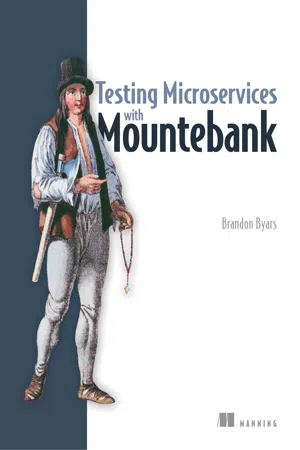
- 240 pages
- English
- ePUB (mobile friendly)
- Available on iOS & Android
Testing Microservices with Mountebank
About this book
Summary Testing Microservices with Mountebank is your guide to the ins and outs of testing microservices with service virtualization. The book offers unique insights into microservices application design and state-of-the-art testing practices that will deepen your microservices skills and improve your applications.Purchase of the print book includes a free eBook in PDF, Kindle, and ePub formats from Manning Publications. About the Technology Even if you lab test each service in isolation, it's challenging—and potentially dangerous—to test a live microservices system that's changing and growing. Fortunately, you can use Mountebank to "imitate" the components of a distributed microservices application to give you a good approximation of the runtime conditions as you test individual services. About the Book Testing Microservices with Mountebank introduces the powerful practice of service virtualization. In it, author Brandon Byars, Mountebank's creator, offers unique insights into microservices application design and state-of-the-art testing practices. You'll expand your understanding of microservices as you work with Mountebank's imposters, responses, behaviors, and programmability. By mastering the powerful testing techniques in this unique book, your microservices skills will deepen and your applications will improve. For real. What's inside
- The core concepts of service virtualization
- Testing using canned responses
- Programming Mountebank
- Performance testing
About the Reader Written for developers familiar with SOA or microservices systems. About the Author Brandon Byars is the author and chief maintainer of Mountebank and a principal consultant at ThoughtWorks. Table of Contents
PART 1 - FIRST STEPS
- Testing microservices
- Taking mountebank for a test drive
PART 2 - USING MOUNTEBANK
- Testing using canned responses
- Using predicates to send different responses
- Adding record/replay behavior
- Programming mountebank
- Adding behaviors
- Protocols
PART 3 - CLOSING THE LOOP
- Mountebank and continuous delivery
- Performance testing with mountebank
Frequently asked questions
- Essential is ideal for learners and professionals who enjoy exploring a wide range of subjects. Access the Essential Library with 800,000+ trusted titles and best-sellers across business, personal growth, and the humanities. Includes unlimited reading time and Standard Read Aloud voice.
- Complete: Perfect for advanced learners and researchers needing full, unrestricted access. Unlock 1.4M+ books across hundreds of subjects, including academic and specialized titles. The Complete Plan also includes advanced features like Premium Read Aloud and Research Assistant.
Please note we cannot support devices running on iOS 13 and Android 7 or earlier. Learn more about using the app.
Information
Part 1. First Steps
Chapter 1. Testing microservices
- A brief background on microservices
- The challenges of testing microservices
- How service virtualization makes testing easier
- An introduction to mountebank
1You probably have better things to spend your time on than reading about the differences between classicists and mockists, but if you can’t help yourself, you can read more at http://martinfowler.com/articles/mocksArentStubs.html.
1.1. A microservices refresher
Figure 1.1. A monolithic application handles view, business, and persistence logic for multiple domains.

1.1.1. The path toward microservices
Figure 1.2. Scaling a monolith means multiple teams have to work in the same codebase.

2See https://queue.acm.org/detail.cfm?id=1142065 for details.
Figure 1.3. Services use different databases for different domains.

Table of contents
- Copyright
- Brief Table of Contents
- Table of Contents
- Preface
- Acknowledgments
- About this book
- About the author
- About the cover illustration
- Part 1. First Steps
- Part 2. Using mountebank
- Part 3. Closing the Loop
- Index
- List of Figures
- List of Tables
- List of Listings